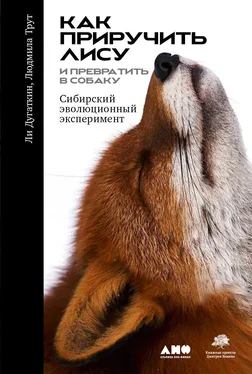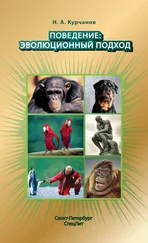Бородин П. Понять человека // Дмитрий Константинович Беляев.
Николай Беляев, интервью с авторами.
Михаил Беляев, интервью с авторами.
Михаил Беляев, интервью с авторами.
А. Коган в книге «Дмитрий Константинович Беляев».
Беляев Д. К. Я верю в добрые начала человека // Вопросы философии. 1986. № 4. С. 93–94.
A. Miklosi. Dog Behavior, Evolution, and Cognition .
Путем подавления активности коркового вещества надпочечника.
I. Plyusnina, I. Oskina, and L. Trut. “An Analysis of Fear and Aggression during Early Development of Behavior in Silver Foxes ( Vulpes vulpes )”. Applied Animal Behaviour Science 32 (1991): 253–268.
Попова Н., Войтенко Н., Трут Л. Изменения в содержании серотонина и 5-оксииндолуксусной кислоты в головном мозге при селекции серебристо-черных лисиц по поведению // Доклады Академии наук СССР. 1975. Т. 223. С. 1498–1500; N. Popova et al. “Genetics and Phenogenetics of Hormonal Characteristics in Animals. 7. Relationships between Brain Serotonin and Hypothalamo-pituitaryadrenal Axis in Emotional Stress in Domesticated and Non-domesticated Silver Foxes”. Genetika 16 (1980): 1865–1870.
Говоря более точно, лисам делали инъекции L-триптофана, химического прекурсора серотонина.
A. Chiodo and M. Owyang. “A Case Study of a Currency Crisis: The Russian Default of 1998”. Federal Reserve Bank of St. Louis Review (November/December 2002): 7–18.
L. Trut. “Early Canid Domestication”, p. 168.
Письмо Джона Макгрю Людмиле Трут.
Письмо Чарльза и Карен Таунсенд Людмиле Трут.
New York Times , 23 Oct 1997.
Временную шкалу этих событий можно найти на сайте Национального института по изучению генома человека: https://unlockinglifescode.org/timeline
C. Rutz and J. H. St. Clair. “The Evolutionary Origins and Ecological Context of Tool Use in New Caledonian Crows”. Behavioural Process 89 (2013): 153–165.
B. Klump et al. “Context- Dependent ‘Safekeeping’ of Foraging Tools in New Caledonian Crows”. Proceedings of the Royal Society B 282 (2015), DOI:10.1098/rspb.2015.0278.
V. Pravosudovand and T. C. Roth. “Cognitive Ecology of Food Hoarding: The Evolution of Spatial Memory and the Hippocampus,” Annual Review of Ecology, Evolution, and Systematics 44 (2013): 173–193.
J. Dally et al. “Food-Caching Western Scrub-Jays Keep Track of Who Was Watching When”. Science 312 (2006): 1662–1665.
M. Wittlinger et al. “The Ant Odometer: Stepping on Stilts and Stumps,” Science 312 (2006): 1965–1967; M. Wittlinger et al. “The Desert Ant Odometer: A Stride Integrator that Accounts for Stride Length and Walking Speed,” Journal of Experimental Biology 210 (2007): 198–207.
B. Hare et al. “The Domestication of Social Cognition in Dogs,” Science 298 (202):1634–1636. Хэйр готовил свою диссертацию, будучи аспирантом Ричарда Рэнгема. Его диссертация называлась «Использование компаративного анализа социально-когнитивных способностей приматов и псовых для моделирования мышления наших миоценовых предков» (Harvard University, 2004).
S. Zuckerman. The Social Life of Monkeys and Apes (New York: Harcourt Brace, 1932).
G. Schino. “Grooming and Agonistic Support: A Meta- analysis of Primate Reciprocal Altruism”. Behavioral Ecology 18 (2007): 115–120; E. Stammbach. “Group Responses to Specially Skilled Individuals in a Macaca fascicularis group”, Behaviour 107 (1988): 687–705; F. de Waal “Food Sharing and Reciprocal Obligations among Chimpanzees”, Human Evolution 18 (1989): 433–459.
A. Harcourt and F. de Waal, eds., Coalitions and Alliances in Humans and Other Animals (Oxford: Oxford University, 1992).
C. Packer. “Reciprocal Altruism in Papio anubis ”, Nature 265 (1977): 441–443.
D. Cheney and R. Seyfarth. How Monkeys See the World (Chicago: University of Chicago, 1990).
Собственные публикации Б. Хэйра по этому вопросу включают: Hare et al. “The Domestication of Social Cognition”; M. Tomasello, B. Hare, and T. Fogleman. “The Ontogeny of Gaze Following in Chimpanzees, Pan troglodytes , and Rhesus Macaques, Macaca mulatta ”, Animal Behaviour 61 (2001): 335–343; S. Itakura et al. “Chimpanzee Use of Human and Conspecific Social Cues to Locate Hidden Food”, Developmental Science 2 (1999): 448–456; M. Tomasello, B. Hare, and B. Agnetta. “Chimpanzees, Pan troglodytes , Follow Gaze Direction Geometrically”, Animal Behaviour 58 (1999): 769–777; B. Hare and M. Tomasello. “Domestic Dogs ( Canis familiaris ) Use Human and Conspecific Social Cues to Locate Hidden Food”, Journal of Comparative Psychology 113 (1999): 173–177; M. Tomasello, J. Call, and B. Hare. “Five Primate Species Follow the Visual Gaze of Conspecifics”, Animal Behaviour 55 (1998): 1063–1069.
A. Miklosi et al. “Use of Experimenter-Given Cues in Dogs”, Animal Cognition 1 (1998): 113–121; A. Miklosi et al. “Intentional Behaviour in Dog- Human Communication: An Experimental Analysis of Showing Behaviour in the Dog”, Animal Cognition 3 (2000): 159–166; K. Soproni et al. “Dogs’ ( Canis familiaris ) Responsiveness to Human Pointing Gestures”, Journal of Comparative Psychology 116 (2002): 27–34.
Спор о том, насколько успешно справляются волки с этим тестом, до сих пор не окончен. См.: A. Miklosi et al. “A Simple Reason for a Big Difference”; A. Miklosi and K. Soproni. “A Comparative Analysis of Animals’ Understanding of the Human Pointing Gesture”, Animal Cognition 9 (2006): 81–93; M. Udell et al. “Wolves Outperform Dogs in Following Human Social Cues”, Animal Behaviour 76 (2008): 1767–1773; C. Wynne, M. Udell, and K. A. Lord. “Ontogeny’s Impacts on Human-Dog Communication”, Animal Behaviour 76 (2008): E1– E4; J. Topal et al. “Differential Sensitivity to Human Communication in Dogs, Wolves, and Human Infants”, Science 325 (2009): 1269–1272; M. Gacsi et al. “Explaining Dog/Wolf Differences in Utilizing Human Pointing Gestures: Selection for Synergistic Shifts in the Development of Some Social Skills”, PLOS ONE 4 (2009), DOI.org/10.1371/journal.pone.0006584; B. Hare et al. “The Domestication Hypothesis for Dogs’ Skills with Human Communication: A Response to Udell et al. (2008) and Wynne et al. (2008)”, Animal Behaviour 79 (2010): E1– E6.
Читать дальше











